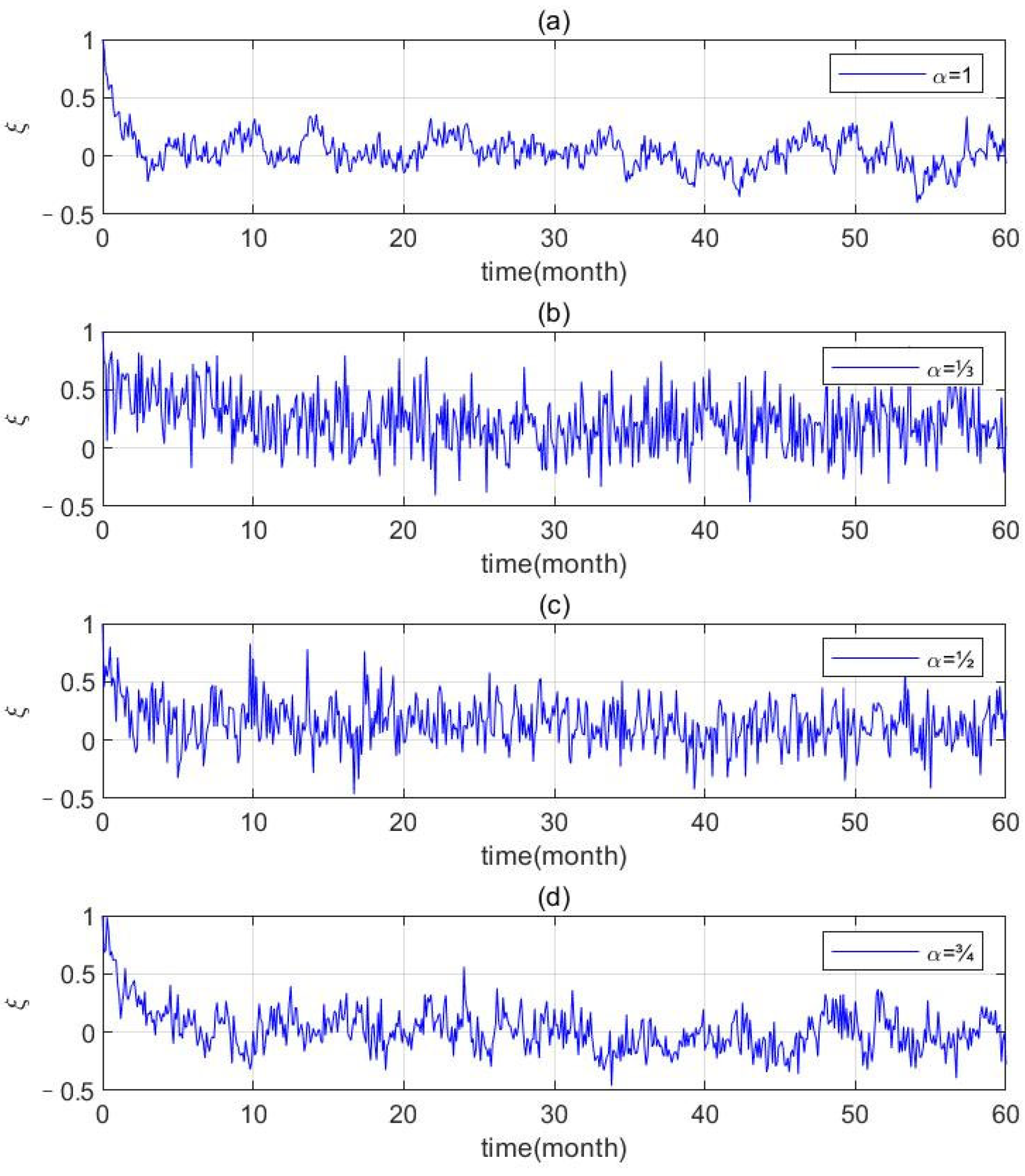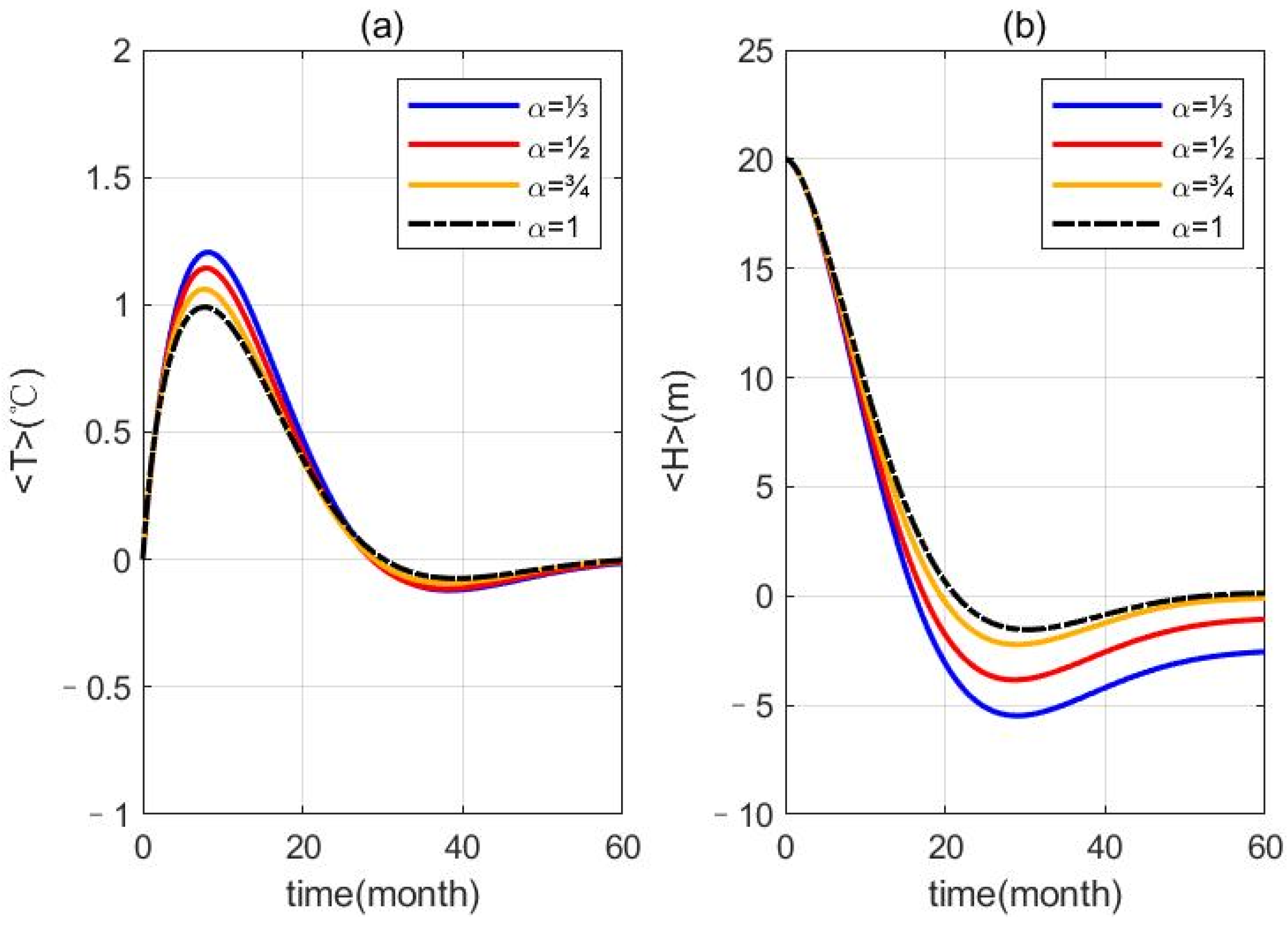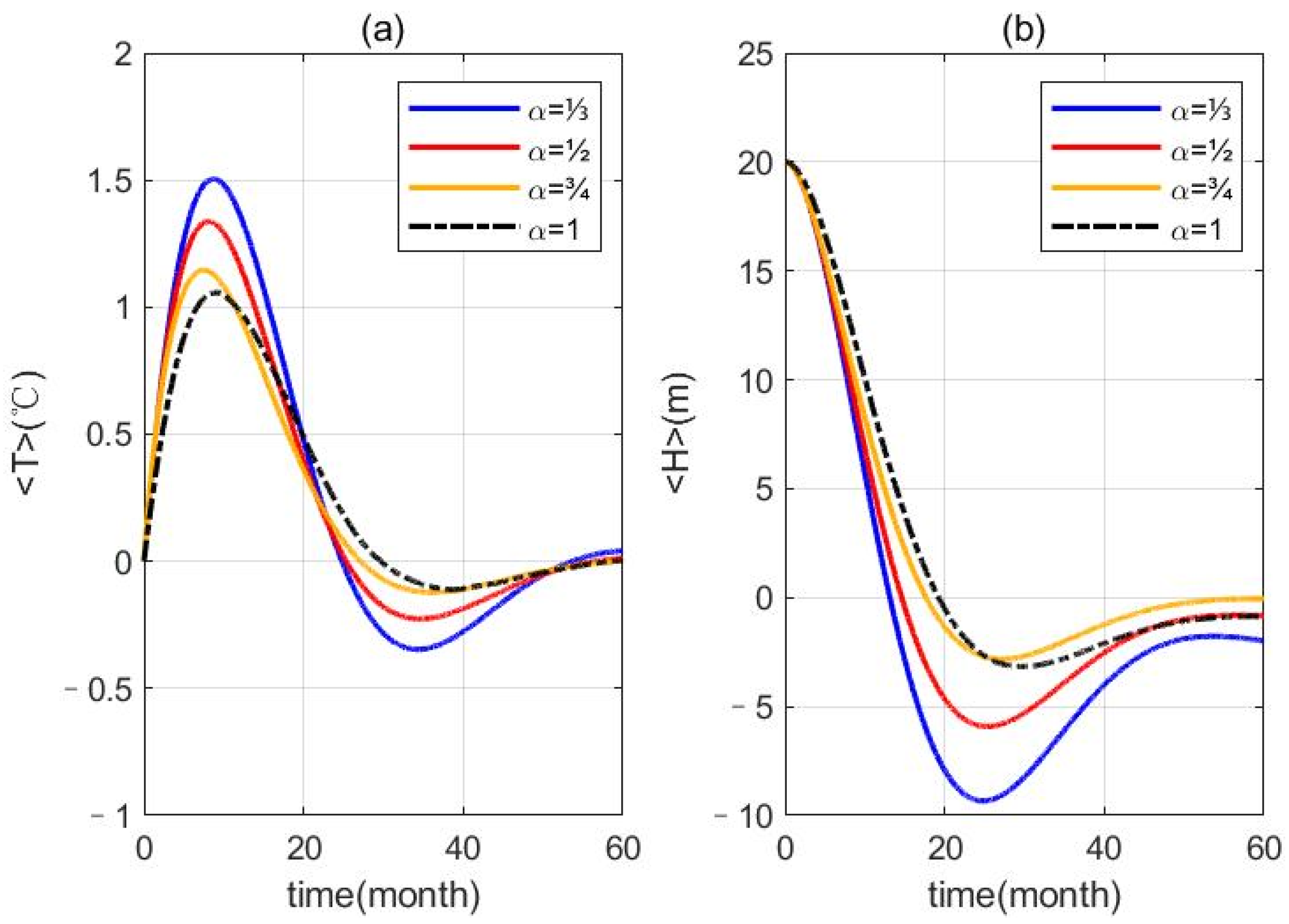The El Niño Southern Oscillation Recharge Oscillator with the Stochastic Forcing of Long-Term Memory
Abstract
:1. Introduction
2. The Model Framework
3. Results
3.1. The Stochastic Forcing of Long-Term Memory
3.2. The Influence of FOU Process on the RO Model
3.3. The Ensemble-Mean Dynamics
4. Conclusions and Discussion
Author Contributions
Funding
Data Availability Statement
Acknowledgments
Conflicts of Interest
References
- Jin, F.-F. Toward Understanding El Niño Southern-Oscillation’s Spatiotemporal Pattern Diversity. Front. Earth Sci. 2022, 10, 899139. [Google Scholar] [CrossRef]
- McPhaden, M.J.; Zebiak, S.E.; Glantz, M.H. ENSO as an Integrating Concept in Earth Science. Science 2006, 314, 1740–1745. [Google Scholar] [CrossRef] [PubMed]
- Battisti, D.S.; Hirst, A.C. Interannual Variability in a Tropical Atmosphere–Ocean Model: Influence of the Basic State, Ocean Geometry and Nonlinearity. J. Atmos. Sci. 1989, 46, 1687–1712. [Google Scholar] [CrossRef]
- Suarez, M.J.; Schopf, P.S. A Delayed Action Oscillator for ENSO. J. Atmos. Sci. 1988, 45, 3283–3287. [Google Scholar] [CrossRef]
- Jin, F.F. An equatorial ocean recharge paradigm for ENSO. Part I: Conceptual model. J. Atmos. Sci. 1997, 54, 811–829. [Google Scholar] [CrossRef]
- Li, Y. A spatiotemporal oscillator model for ENSO. Theor. Appl. Climatol. 2024. [Google Scholar] [CrossRef]
- Lybarger, N.D.; Shin, C.; Stan, C. MJO Wind Energy and Prediction of El Niño. J. Geophys. Res. Ocean. 2020, 125, e2020JC016732. [Google Scholar] [CrossRef]
- Tang, Y.; Yu, B. MJO and its relationship to ENSO. J. Geophys. Res. Atmos. 2008, 113, D14106. [Google Scholar] [CrossRef]
- Zavala-Garay, J.; Zhang, C.; Moore, A.M.; Kleeman, R. The Linear Response of ENSO to the Madden–Julian Oscillation. J. Clim. 2005, 18, 2441–2459. [Google Scholar] [CrossRef]
- Zhang, C.; Gottschalck, J. SST Anomalies of ENSO and the Madden–Julian Oscillation in the Equatorial Pacific. J. Clim. 2002, 15, 2429–2445. [Google Scholar] [CrossRef]
- Kessler, W.S.; McPhaden, M.J.; Weickmann, K.M. Forcing of intraseasonal Kelvin waves in the equatorial Pacific. J. Geophys. Res. Ocean. 1995, 100, 10613–10631. [Google Scholar] [CrossRef]
- Yu, S.; Fedorov, A.V. The Essential Role of Westerly Wind Bursts in ENSO Dynamics and Extreme Events Quan-tified in Model “Wind Stress Shaving” Experiments. J. Clim. 2022, 35, 7519–7538. [Google Scholar] [CrossRef]
- Tan, X.; Tang, Y. A study of the effects of westerly wind bursts on ENSO based on CESM. Clim. Dyn. 2020, 54, 885–899. [Google Scholar] [CrossRef]
- Lopez, H.; Kirtman, B.P. Westerly wind bursts and the diversity of ENSO in CCSM3 and CCSM4. Geophys. Res. Lett. 2013, 40, 4722–4727. [Google Scholar] [CrossRef]
- Lengaigne, M.; Guilyardi, E.; Boulanger, J.-P.; Menkes, C.; Delecluse, P.; Inness, P.; Cole, J.; Slingo, J. Triggering of El Niño by westerly wind events in a coupled general circulation model. Clim. Dyn. 2004, 23, 601–620. [Google Scholar]
- Perigaud, C.M.; Cassou, C. Importance of oceanic decadal trends and westerly wind bursts for forecasting El Niño. Geophys. Res. Lett. 2000, 27, 389–392. [Google Scholar] [CrossRef]
- Moore, A.M.; Kleeman, R. Stochastic Forcing of ENSO by the Intraseasonal Oscillation. J. Clim. 1999, 12, 1199–1220. [Google Scholar] [CrossRef]
- Jin, F.; Lin, L.; Timmermann, A.; Zhao, J. Ensemble-mean dynamics of the ENSO recharge oscillator under state-dependent stochastic forcing. Geophys. Res. Lett. 2007, 34, L03807. [Google Scholar] [CrossRef]
- Levine, A.F.Z.; Jin, F. Noise-Induced Instability in the ENSO Recharge Oscillator. J. Atmos. Sci. 2010, 67, 529–542. [Google Scholar] [CrossRef]
- Levine, A.F.Z.; Jin, F.F. A simple approach to quantifying the noise–ENSO interaction. Part I: Deducing the state-dependency of the windstress forcing using monthly mean data. Clim. Dyn. 2017, 48, 1–18. [Google Scholar] [CrossRef]
- Yuan, N.; Fu, Z.; Liu, S. Extracting climate memory using Fractional Integrated Statistical Model: A new perspective on climate prediction. Sci. Rep. 2014, 4, 6577. [Google Scholar] [CrossRef]
- Du, M.; Wang, Z.; Hu, H. Measuring memory with the order of fractional derivative. Sci. Rep. 2013, 3, 3431. [Google Scholar] [CrossRef]
- Ascione, G.; Mishura, Y.; Pirozzi, E. Fractional Ornstein-Uhlenbeck Process with Stochastic Forcing, and its Ap-plications. Methodol. Comput. Appl. Probab. 2021, 23, 53–84. [Google Scholar] [CrossRef]
- Kleptsyna, M.L.; Le Breton, A. Statistical Analysis of the Fractional Ornstein–Uhlenbeck Type Process. Stat. Inference Stoch. Process. 2002, 5, 229–248. [Google Scholar] [CrossRef]
- Shao, Y. The fractional Ornstein-Uhlenbeck process as a representation of homogeneous Eulerian velocity turbulence. Phys. D Nonlinear Phenom. 1995, 83, 461–477. [Google Scholar] [CrossRef]
- Burgers, G.; Jin, F.; van Oldenborgh, G.J. The simplest ENSO recharge oscillator. Geophys. Res. Lett. 2005, 32, L13706. [Google Scholar] [CrossRef]
- Comte, F.; Renault, E. Long memory continuous time models. J. Econom. 1996, 73, 101–149. [Google Scholar] [CrossRef]
- Samko, S.G.; Kilbas, A.A.; Marichev, O.I. Fractional Integrals and Derivatives: Theory and Applications; Gorden and Breach Publishers: Philadelphia, PA, USA, 1993. [Google Scholar]
- Kilbas, A.A.; Srivastava, H.M.; Trujillo, J.J. Theory and Applications of Fractional Differential Equations; North-Holland Mathematical Studies; Elsevier (North-Holland) Science Publishers: Amsterdam, The Netherlands; London, UK; New York, NY, USA, 2006. [Google Scholar]
- Mainardi, F. On some properties of the Mittag-Leffler function Eα(−tα), completely monotone for t > 0 with 0 < α < 1. Discret. Contin. Dyn. Syst. B 2014, 19, 2267–2278. [Google Scholar]
- Izumo, T.; Colin, M. Improving and Harmonizing El Niño Recharge Indices. Geophys. Res. Lett. 2022, 49, e2022GL101003. [Google Scholar] [CrossRef]
- Stuecker, M.F.; Timmermann, A.; Jin, F.-F.; Chikamoto, Y.; Zhang, W.; Wittenberg, A.T.; Widiasih, E.; Zhao, S. Revisiting ENSO/Indian Ocean Dipole phase relationships. Geophys. Res. Lett. 2017, 44, 2481–2492. [Google Scholar] [CrossRef]
- Stuecker, M.F. The climate variability trio: Stochastic fluctuations, El Niño, and the seasonal cycle. Geosci. Lett. 2023, 10, 51. [Google Scholar] [CrossRef]
- Chen, H.; Jin, F. Fundamental Behavior of ENSO Phase Locking. J. Clim. 2020, 33, 1953–1968. [Google Scholar] [CrossRef]
- Stein, K.; Timmermann, A.; Schneider, N.; Jin, F.-F.; Stuecker, M.F. ENSO Seasonal Synchronization Theory. J. Clim. 2014, 27, 5285–5310. [Google Scholar] [CrossRef]
- An, S.; Jin, F. Linear solutions for the frequency and amplitude modulation of ENSO by the annual cycle. Tellus A Dyn. Meteorol. Oceanogr. 2011, 63, 238–243. [Google Scholar] [CrossRef]




Disclaimer/Publisher’s Note: The statements, opinions and data contained in all publications are solely those of the individual author(s) and contributor(s) and not of MDPI and/or the editor(s). MDPI and/or the editor(s) disclaim responsibility for any injury to people or property resulting from any ideas, methods, instructions or products referred to in the content. |
© 2024 by the authors. Licensee MDPI, Basel, Switzerland. This article is an open access article distributed under the terms and conditions of the Creative Commons Attribution (CC BY) license (https://creativecommons.org/licenses/by/4.0/).
Share and Cite
Li, X.; Li, Y. The El Niño Southern Oscillation Recharge Oscillator with the Stochastic Forcing of Long-Term Memory. Fractal Fract. 2024, 8, 121. https://doi.org/10.3390/fractalfract8020121
Li X, Li Y. The El Niño Southern Oscillation Recharge Oscillator with the Stochastic Forcing of Long-Term Memory. Fractal and Fractional. 2024; 8(2):121. https://doi.org/10.3390/fractalfract8020121
Chicago/Turabian StyleLi, Xiaofeng, and Yaokun Li. 2024. "The El Niño Southern Oscillation Recharge Oscillator with the Stochastic Forcing of Long-Term Memory" Fractal and Fractional 8, no. 2: 121. https://doi.org/10.3390/fractalfract8020121





